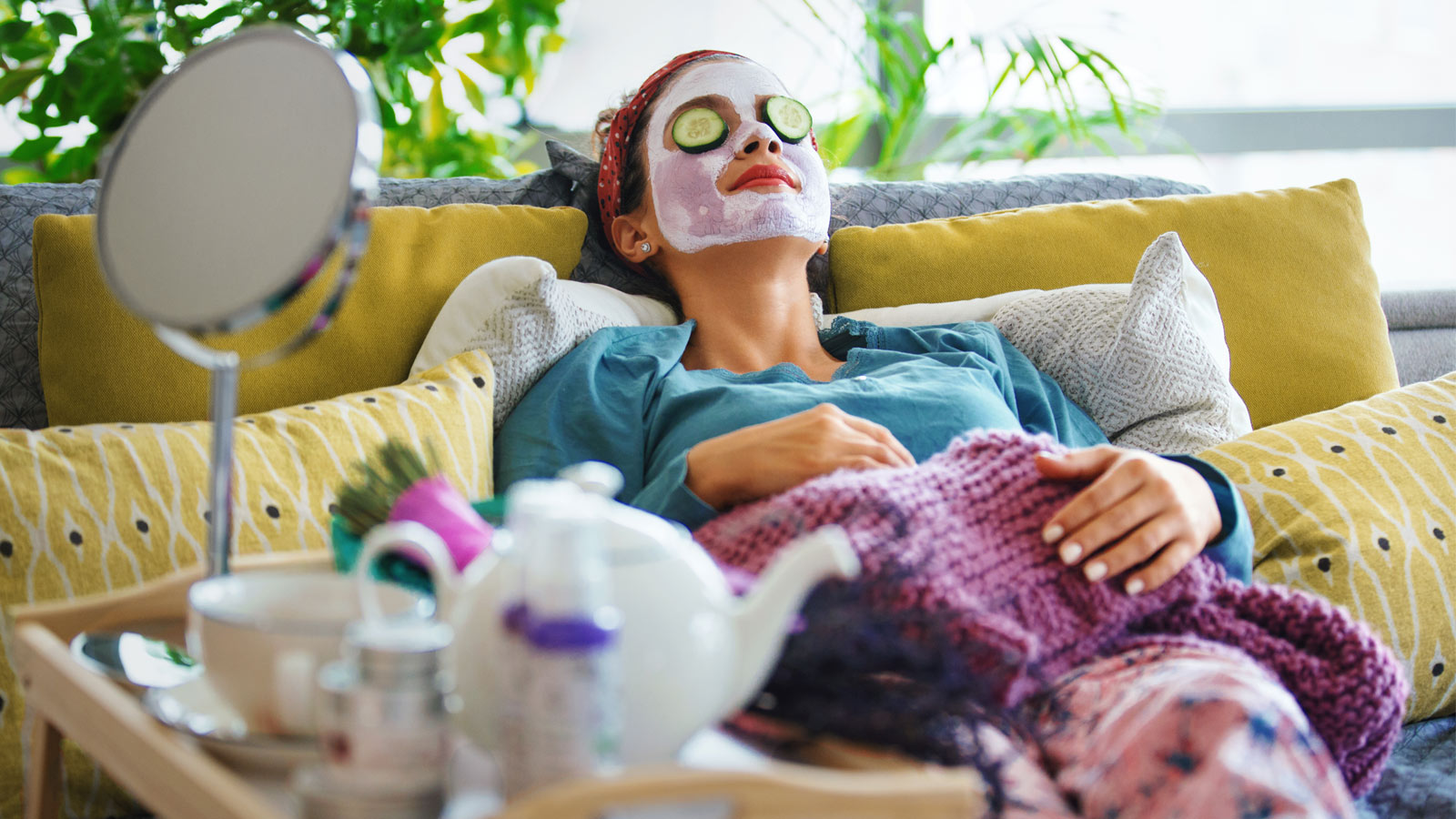In this Decompression Session, we’ve created an easy list of 7 steps to create your own day spa at home. We all deserve to self-indulge, but massage appointments and facials are expensive and require planning. Instead, get yourself set up to stress-down in the comfort of your own home. Anyone can have their own little oasis.
We’ll talk about how to set the mood, items you’ll need, and how to set up your space so you can have an off-the-cuff unwinding session whenever you need one.
1. Set Your Spa Space
Everyone’s home is different, so where you choose to locate your DIY spa will depend on your rooms and layout. One obvious choice is the bathroom because you may want to do your spa time in the tub. This is also optimal because the bathroom is typically a small space where it’s easy to enclose. But because most bathrooms are on the smaller side, this is also a limitation if you’ll want to spread out.
If you’re going to use a room you’re in a lot, like your bedroom or the living room, choose a section of it to be your dedicated spa space. You want to be transported, so transform a section of the room for privacy and peace.
If you choose a larger room, delineate your spa space. If you have a curtain or divider, great, but if not, face yourself in a direction that clears your field of vision of anything that stresses you out. Make sure your computer is out of view, for example. Silence your phone and place it out of reach. Even just setting up a blanket and placing a candle nearby will have a space-creating effect.
2. Make Your Spa Playlist
Day spas all have a familiar vibe, and it starts with music. New Age instrumentals are a go-to for a relaxation mood soundtrack, but there are many different types of easy listening you can opt for. Think ambient sounds over familiar tunes, and melodic over percussive. You don’t even have to go with music — white noise and nature sounds are all excellent sonic background to use in creating your own personal sound bath.
For tried-and-true meditative music, we love Music for Airports by Brian Eno, or the repetitive piano solos of Philip Glass. But you can also opt for recordings of whale song, waterfalls, Gregorian chants, or even thunderstorms — whatever brings you peace.
How much you curate your audio experience is up to you. If you want to take the easy route, you can simply search “spa music” online or on your music app. But you can also create your own playlist of songs to move you through a relaxed state. If you want to create a 30- or 60-minute experience, pick something with brighter tones or a little liveliness for the end of the playlist to ease you back into reality and wake you up back into your body.
3. Ohm Your Aroma
Now that you’ve got your soundscape settled, figure out your smell-scape. A soothing smell can take you away — your olfactory senses create strong associations. Much like your playlist, you can choose a smell with known relaxing qualities like lavender, or you can make it personal by choosing a scent you associate with nostalgia. For example, choose a forest-scented candle if you grew up in the Northeast and have fond memories of the smell of pines.
How you permeate and perfume your spa is also your choice. You can choose candles, which have the dual benefit of soft light (more on lighting below). They come in almost any scent you can think of, from flowers to birthday cake. If you want a headier ambience, you can invest in some incense or an essential oil diffuser. Or go natural — actual flowers, herbs, or plants can add essence, or sachets of potpourri.
Whatever you choose, a good rule of thumb is to keep it relatively subtle. A strong smell might overwhelm your experience and distract you from disappearing into full relaxation. Another thing to avoid is too many different competing smells. If you’re using a bath bomb or scented lotions, try to use candles or oils that complement them. You can experiment with your aromas until you find the right mix — all part of the fun of home spa creation.
4. Find Your Light (or Dark)
Obviously, you want soft lighting for your home spa. Since you’re at home, you might mostly have lighting that is practical and too bright for home spa purposes. If your switches don’t have built-in dimmers, you can just supplement your spa with its own lighting.
We already mentioned candles, and one or two lighted wicks might be all you need for your home spa. The movement and shadow of a candle flame is naturally soothing and won’t over-light your space. Another option is simple natural light. There’s no reason your spa time can’t be a daytime experience, and indirect sunlight is lovely, revitalizing, and free.
If you want to invest in some pro-level spa lighting, there are a range of products available, from infrared-light therapy lamps to color-changing mood cubes. Or, if you want to try no lighting, there’s always the sensory deprivation option — complete darkness. This requires little more than turning off the lights and closing the blinds. (Get blackout curtains if you really want to go for it.) Just make sure your setup is safe so you won’t trip over anything in the dark.
5. Make a Grocery Run
A trip to your local supermarket has everything you need for your home spa perishables. From DIY face masks to a refreshing spa beverage, stock your fridge with a few essentials. If you decide to become an expert, you can find lots of recipes online for face peels, hair masks, and the like. We’ve just listed a few ideas below to get you started:
- Cucumber Water: All you need is a cucumber and some filtered water. Slice the cucumber and float the disks in water overnight in the fridge. Place a glass next to your bath or mat, and save a few disks for your eyelids.
- Egg White Face Mask: Just one ingredient, that’s it. Separate, whisk until frothy, and apply. Then leave it on for 10-15 minutes and rinse, and then call all your friends to tell them you’ve got egg on your face.
- Bath Salts: All you really need is epsom salt, an inexpensive ingredient you can find at most grocery stores. Just add a cup to the tub and soak. If you want to get fancy, you can find recipes to add ingredients for additional aroma and body benefits.
These are just a few of the easiest DIY treatments. Check online for more recipes and ideas.
6. DIY Massage Tools and Techniques
Here’s where you might want to do a little self-educating and invest in a couple of basics so you can work out the knots on your own. An inexpensive yoga mat and foam roller are worthwhile investments. To get the most out of your massage and make sure you’re doing it correctly, find a good online video tutorial. (Search “foam roller tutorial” for a bunch of options.)
Feel free to play the video tutorial as you roll out your back, or just memorize the steps and do it peacefully to your playlist. You can also do very simple, relaxing postures like lying on your back with your neck at rest and holding your knees, which helps release your lower back.
If you don’t want to move at all, download or stream a body-scan meditation to guide you through a mindfulness exercise from head to toe. You might want to turn the thermostat up a degree or two before you begin a prone exercise, or get under a lightweight blanket, since your body temperature may drop slightly in a resting state.
7. Take Your Spa with You
Now that you’ve got your basic home spa setup, you should be able to relax at home. But since you don’t need much, and most of it is portable, you can pack your spa and take it with you if you travel or want to keep it on hand for a quick chillout anywhere you can find a private space. Enjoy the peace, and namaste!
WCU provides career guidance and assistance but cannot guarantee employment. The views and opinions expressed are those of the individuals and do not necessarily reflect the beliefs or position of the school or of any instructor or student.



